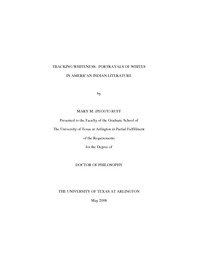| dc.description.abstract | Although whites have pervaded the lives and literatures of American Indians since contact, their own portrayals of whites have remained, for the most part, unexplored. I examine selected works of nineteenth and twentieth-century American Indian writers to discern ways that whites are portrayed collectively and individually. The most salient categories of whites emerge early on as government officials, educators, and missionaries, those most directly engaged in the "civilizing mission." Similar categories of white characters, with the addition of white doctors, are found throughout twentieth-century American Indian fiction. Also in these works, numerous individual whites are portrayed as multidimensional, dynamic characters whose actions range from greedy, self-serving, and contemptuous to benevolent, respectful, and compassionate. Viewing these portrayals through the lenses of postcolonialist theory and white studies reveals that American Indian writers have probed beneath the white skin to see into the hearts of these people who have invaded their lands and lives.
Beginning with collective portrayals of whites in nineteenth-century nonfiction works of William Apess, George Copway, Sarah Winnemucca Hopkins, Charles Eastman, and Zitkala-a, this study then examines collective portrayals of whites in three twentieth-century novels of Leslie Marmon Silko, Louise Erdrich, and Linda Hogan. Individual portrayals of whites follow, as found not only in works of Silko, Erdrich, and Hogan, but also in those of D'Arcy McNickle, John Joseph Mathews, N. Scott Momaday, James Welch, Michael Dorris, Sherman Alexie, Greg Sarris, and David Treuer. Overall, portrayals of white characters range from evil to good, from one-dimensional and stereotypical to richly complex and enigmatic. Exposing whiteness in such an array serves to displace it from its center of superiority, privilege, and power. | en_US |


